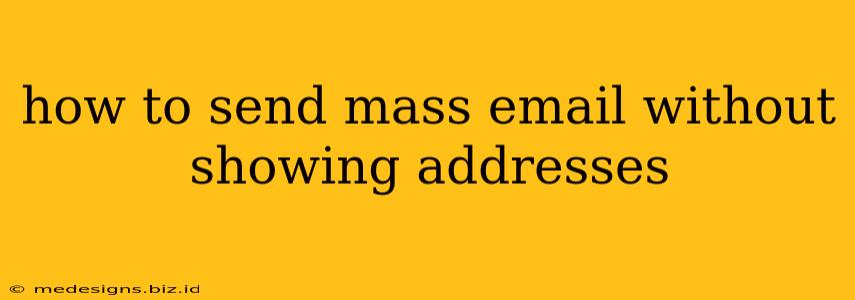How to Send Mass Emails Without Showing Addresses: Protecting Privacy and Maintaining Compliance
Sending mass emails is a powerful marketing and communication tool, but revealing recipients' email addresses to each other raises serious privacy concerns and can even lead to legal issues. Luckily, there are ways to send bulk emails while keeping everyone's information confidential. This guide explains how to achieve this, focusing on best practices and ensuring compliance with relevant regulations like GDPR and CAN-SPAM.
Understanding the Privacy Concerns
Before diving into the methods, let's clarify why hiding email addresses in mass emails is crucial:
- Privacy: Revealing recipient email addresses violates the privacy of your subscribers. They haven't consented to having their personal information shared with other recipients.
- Spam and Abuse: Exposing email addresses in mass emails increases the risk of spam and phishing attacks targeting your recipients.
- Legal Compliance: Regulations like GDPR and CAN-SPAM mandate that you respect user privacy and obtain explicit consent for email marketing. Showing addresses directly contradicts this.
Methods for Sending Mass Emails Anonymously
The key is to use email marketing platforms designed for privacy and compliance. These platforms use techniques like BCC (Blind Carbon Copy) or other advanced features to ensure that recipients only see their own email addresses and not those of other subscribers.
1. Utilizing the BCC Field:
Most email clients offer a BCC field. While convenient for smaller lists, using BCC for large mass emails can become cumbersome and may even be blocked by some email providers due to server limitations. It's not the ideal solution for large-scale email campaigns.
2. Employing Email Marketing Platforms:
This is the most reliable and efficient method. Reputable email marketing platforms are specifically designed to handle mass email campaigns while protecting recipient privacy. They employ various techniques, including:
- BCC functionality optimized for large lists: They handle the technical complexities of managing large BCC lists.
- Advanced features for personalization: While hiding addresses, platforms allow personalized content within individual emails. This enhances engagement and improves deliverability.
- Compliance features: Many offer features that help ensure compliance with data protection regulations like GDPR and CAN-SPAM. They often include options for managing opt-ins, providing unsubscribe links, and maintaining detailed records of email activity.
Choosing the Right Email Marketing Platform
When selecting a platform, consider these factors:
- Reputation and reliability: Opt for a platform with a proven track record of delivering emails effectively and respecting user privacy.
- Features: Look for features like robust segmentation, personalization options, and detailed analytics.
- Compliance: Ensure the platform is GDPR and CAN-SPAM compliant.
- Pricing: Compare pricing plans to find one that fits your budget and mailing list size.
Best Practices for Privacy-Conscious Email Marketing
Beyond the technical aspects, remember these essential best practices:
- Obtain explicit consent: Always obtain clear consent before adding subscribers to your email list.
- Provide a clear unsubscribe option: Make it easy for recipients to unsubscribe from your emails.
- Maintain data security: Implement robust security measures to protect your subscribers' data.
- Regularly review your email list: Remove inactive or invalid addresses to maintain a clean list and improve deliverability.
Conclusion:
Sending mass emails without showing addresses is essential for protecting privacy and complying with regulations. While using the BCC field might work for small lists, employing a dedicated email marketing platform is the most effective and secure method. By choosing a reputable platform and adhering to best practices, you can leverage the power of email marketing while upholding your subscribers' privacy and maintaining compliance.
